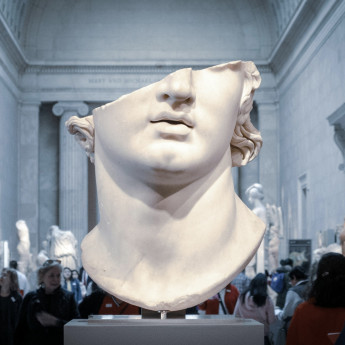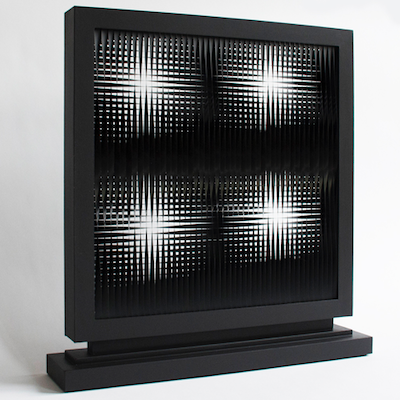


Details
Artist
Styles
From Síntesis Series - Mixed media on plexiglass - Signed and numbered on a label affixed to the reverse // Rafael Jesus Soto’s La Escalera Azul is a captivating mixed-media work that plays with perception, illusion, and dimensionality. Part of the Síntesis series, the piece is constructed using Plexiglas and features horizontal black and white lines that create a visual rhythm. Over this structured backdrop, thin blue and black forms appear to float, creating an optical illusion of depth and movement. The blue lines, resembling the form of a ladder, stand out, drawing attention to the lower portion of the piece, where the blue tone dominates. The precision of the lines and their arrangement produce a kinetic effect as the viewer moves, shifting the perception of the artwork from static to dynamic. Soto’s ability to manipulate light and space through minimal elements transforms La Escalera Azul into an interactive visual experience, where the viewer’s movement activates the work. Signed and numbered on the reverse, this piece exemplifies Soto’s signature approach to kinetic and optical art.
La Escalera Azul , 1979
form
Medium
Size
49.4 x 34.5 X 12 cm
- Inches
- Centimeters
Edition
Price
- USD
- EUR
- GBP
Details
Artist
Styles
From Síntesis Series - Mixed media on plexiglass - Signed and numbered on a label affixed to the reverse // Rafael Jesus Soto’s La Escalera Azul is a captivating mixed-media work that plays with perception, illusion, and dimensionality. Part of the Síntesis series, the piece is constructed using Plexiglas and features horizontal black and white lines that create a visual rhythm. Over this structured backdrop, thin blue and black forms appear to float, creating an optical illusion of depth and movement. The blue lines, resembling the form of a ladder, stand out, drawing attention to the lower portion of the piece, where the blue tone dominates. The precision of the lines and their arrangement produce a kinetic effect as the viewer moves, shifting the perception of the artwork from static to dynamic. Soto’s ability to manipulate light and space through minimal elements transforms La Escalera Azul into an interactive visual experience, where the viewer’s movement activates the work. Signed and numbered on the reverse, this piece exemplifies Soto’s signature approach to kinetic and optical art.
- Recently Added
- Price (low-high )
- Price (high-low )
- Year (low-high )
- Year (high-low )
What is interactive art?
Interactive art is a form of art where the spectator is actively involved by the artist to achieve the artwork's purpose. This involvement can include allowing the visitor to walk around, in, or on the art installation, or even becoming a part of the artwork itself. Works in this category often feature computers, sensors, and interfaces that respond to various inputs such as meteorological changes, heat, motion, or other types of data programmed by the artist.






























